Mechanical Behavior of Special-Shaped Double-Web Steel-Reinforced Concrete Column Joints
Abstract
:1. Introduction
2. Joint Design and Finite Element Analysis
2.1. Form of Joint
2.2. Checking Calculation of Joints
2.3. Material Constitutive Relation Selection
2.4. Verification of Finite Element Model
2.5. Establishment of Finite Element Model
- (1)
- Concrete and L-shaped steel-reinforced member: concrete and steel-reinforced member are surface to surface contact, with the inner surface of the steel-reinforced member with high elastic modulus selected as the main surface. The softer concrete surface as the slave surface, with the distance as the default option. The tangential property is defined as having friction with using the penalty function operation method, and the default friction coefficient is 0.6 [16]. The normal attribute is defined as hard contact, and this definition indicates that when the inner surface of the steel is separated from the outer surface of the concrete, the constraint is also removed. The contact pressure between the two surfaces is zero.
- (2)
- Between the steel components: L-shaped steel-reinforced member and steel beam, head studs and column flange are welded. Choose TIE to constrain two surfaces to simulate the weld and the surface of L-shaped steel-reinforced member as the main surface. Then take the welding surface of steel beam and head stud as the slave surface. Its binding area is selected using Joint region (point set method) as the slave joint, and the distance is the default option.
- (3)
- Concrete and joint-transmitting elements: concrete and head studs are embedded contact. The head studs are selected to be embedded in the concrete.
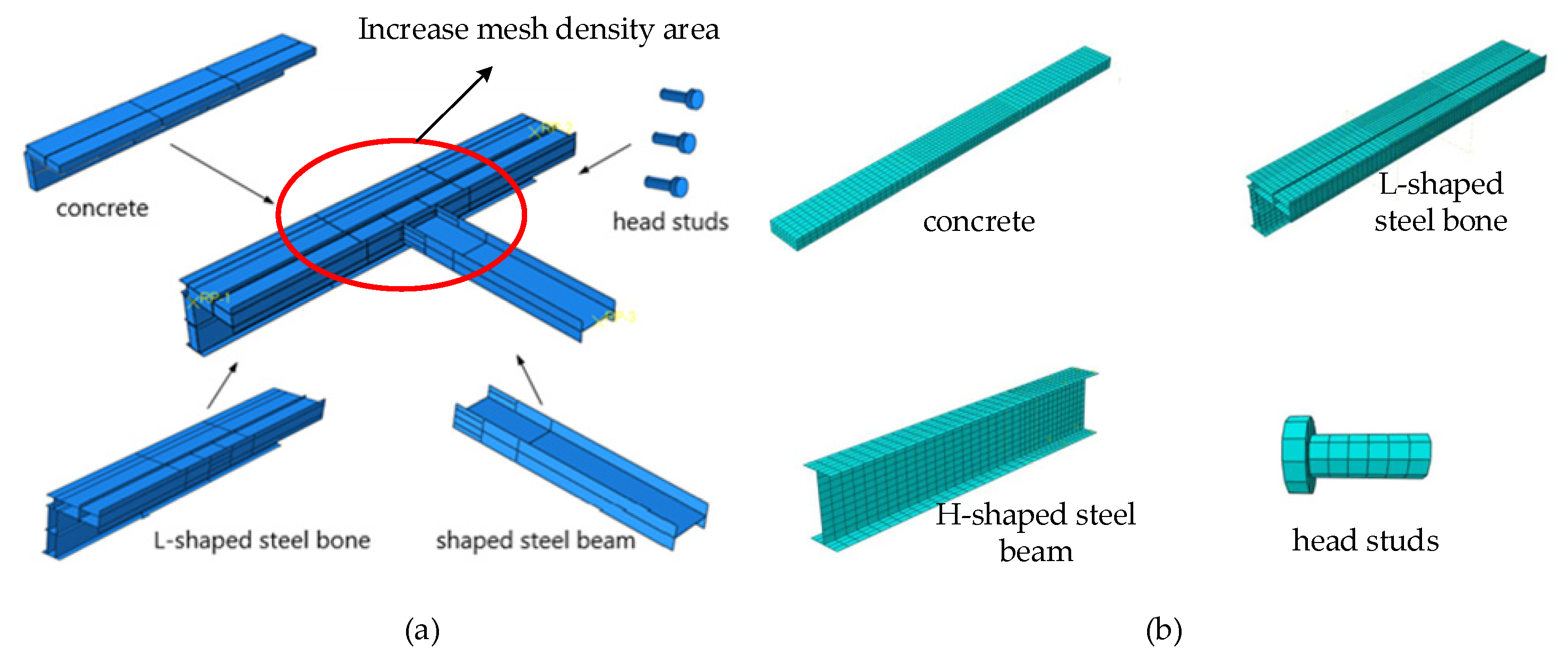
3. Calculation Results and Analysis
3.1. Calculation Results and Analysis of Monotonic Loading
3.1.1. Load-Displacement Curve Analysis
3.1.2. Analysis of Yield State and Failure Mode of Joints
3.2. Calculation Results and Analysis of Cyclic Loading
3.2.1. Hysteresis Curve Analysis
3.2.2. Analysis of Energy-Consuming Capacity
3.2.3. Strength Degradation and Stiffness Degradation Analysis
4. Conclusions
- (1)
- Comparing the damage forms of five joints of S series, only the beam ends of S-2 and S-3 joints form full-section plastic hinges. The mechanical properties of S series beam-column joints are better under monotonic loading, and all of them have greater improvement compared with JD. Especially S-2 and S-3 have obvious improvement, the yield bearing capacity is 14.8% and 10.1% higher with the ultimate bearing capacity is 13.5% and 10.9% higher.
- (2)
- When applying cyclic reciprocating load to the joints, S series joints all show good hysteresis performance, with full hysteresis curve. When reaching the ultimate bearing capacity, the concrete loses bearing capacity and strength and stiffness decrease due to the formation of the destruction cone between the cylindrical head and the surrounding concrete. But the joints have good ductility before and after reaching the ultimate bearing capacity.
- (3)
- The mechanical properties and damage modes of joints are related to the distribution of studs. The studs at the connection between the beam web and the column are obviously stressed, and the arrangement of studs here can effectively improve the force transmission at the beam-column node. Multiple rows of studs can enhance the interaction with concrete and form plastic hinges in the beam section. The single-row arrangement tends to lead to local crushing of the concrete and should be avoided.
Author Contributions
Funding
Data Availability Statement
Conflicts of Interest
References
- Lai, B.; Yang, L.; Xiong, M. Numerical simulation and data-driven analysis on the flexural performance of steel reinforced concrete composite members. Eng. Struct. 2021, 247, 113200. [Google Scholar] [CrossRef]
- Nguyen, T.; Thai, H.; Li, D.; Wang, J.; Uy, B.; Ngo, T. Behaviour and design of eccentrically loaded CFST columns with high strength materials and slender sections. J. Constr. Steel Res. 2022, 188, 107004. [Google Scholar] [CrossRef]
- Hassam, M.; Guo, L.; Jia, C. Concentric and eccentric compression performance of multiple-cell cruciform CFSTs. J. Constr. Steel Res. 2022, 192, 107205. [Google Scholar] [CrossRef]
- Zhan, X.; Qin, Z.; Li, J.; Chen, Y. Global stability of axially loaded partially encased composite column with L-shaped section. J. Constr. Steel Res. 2023, 200, 107671. [Google Scholar] [CrossRef]
- Chen, Z.; Mo, L.; Li, S.; Liang, Y.; Xu, D. Seismic behavior of steel reinforced concrete L-shaped columns under compression-bending-shear-torsion combined action. J. Build. Eng. 2021, 42, 102498. [Google Scholar] [CrossRef]
- Chen, Z.; Xu, J.; Zhou, T.; Su, J. Seismic research on column base joint of L-shaped CFST columns under cyclic loading. Structures 2022, 45, 1212–1224. [Google Scholar] [CrossRef]
- CECS 159-2004; Technical Specification for Structures with Concrete-Filled Rectangular Steel Tube. China Association for Engineering Construction Standardization: Beijing, China, 2004.
- Spavier, P.T.D.S.; Debs, A.L.H.C. Experimental analysis of beam-to-column connection with partially encased concrete column with varying inertia axis. J. Constr. Steel Res. 2022, 194, 107325. [Google Scholar] [CrossRef]
- Zhou, W.; Li, B.; Zhao, G.; Gao, C. Experimental study of seismic performance of PEC column-steel beam 3D frame with endplate connection. J. Constr. Steel Res. 2023, 202, 107765. [Google Scholar] [CrossRef]
- Guo, L.; Wang, J.; Wang, W.; Hu, Z. Experimental and numerical investigations of bolted assembled joints to concrete encased CFST columns with different connection details. J. Constr. Steel Res. 2023, 201, 107739. [Google Scholar] [CrossRef]
- Gautham, A.; Sahoo, D.R. Performance of SRC column-RC beam joints under combined axial and cyclic lateral loadings. Eng. Struct. 2022, 260, 114218. [Google Scholar] [CrossRef]
- GB50011-2010; Code for Seismic Design of Buildings. China Architecture & Building Press: Beijing, China, 2016.
- Han, L.; Yao, G.; Tao, Z. Performance of concrete-filled thin-walled steel tubes under pure torsion. Thin-Walled Struct. 2007, 45, 24–36. [Google Scholar] [CrossRef]
- Hibbitt, K.S. ABAQUS/standard User’s Manual, Version 6.5.; Dassault Systèmes Corp.: Waltham, MA, USA, 2005. [Google Scholar]
- Cheng, Y.; Yang, Y.; Li, B.; Liu, J.; Chen, Y.F. Mechanical behavior of T-shaped CFST column to steel beam joint. J. Constr. Steel Res. 2021, 187, 106774. [Google Scholar] [CrossRef]
- Chen, Z.; Mohammed, A.; Du, Y.; Mashrah, W.A.H.; Zhao, B.; Huang, J. Experimental and numerical study on seismic performance of square and l-shaped Concrete-filled steel tubes column Frame-Buckling steel plate shear walls. Eng. Struct. 2023, 274, 115155. [Google Scholar] [CrossRef]
- JGJ 99-2015; Technical Specification for Steel Structure of Tall Buildings. China Architecture & Building Press: Beijing, China, 2015.

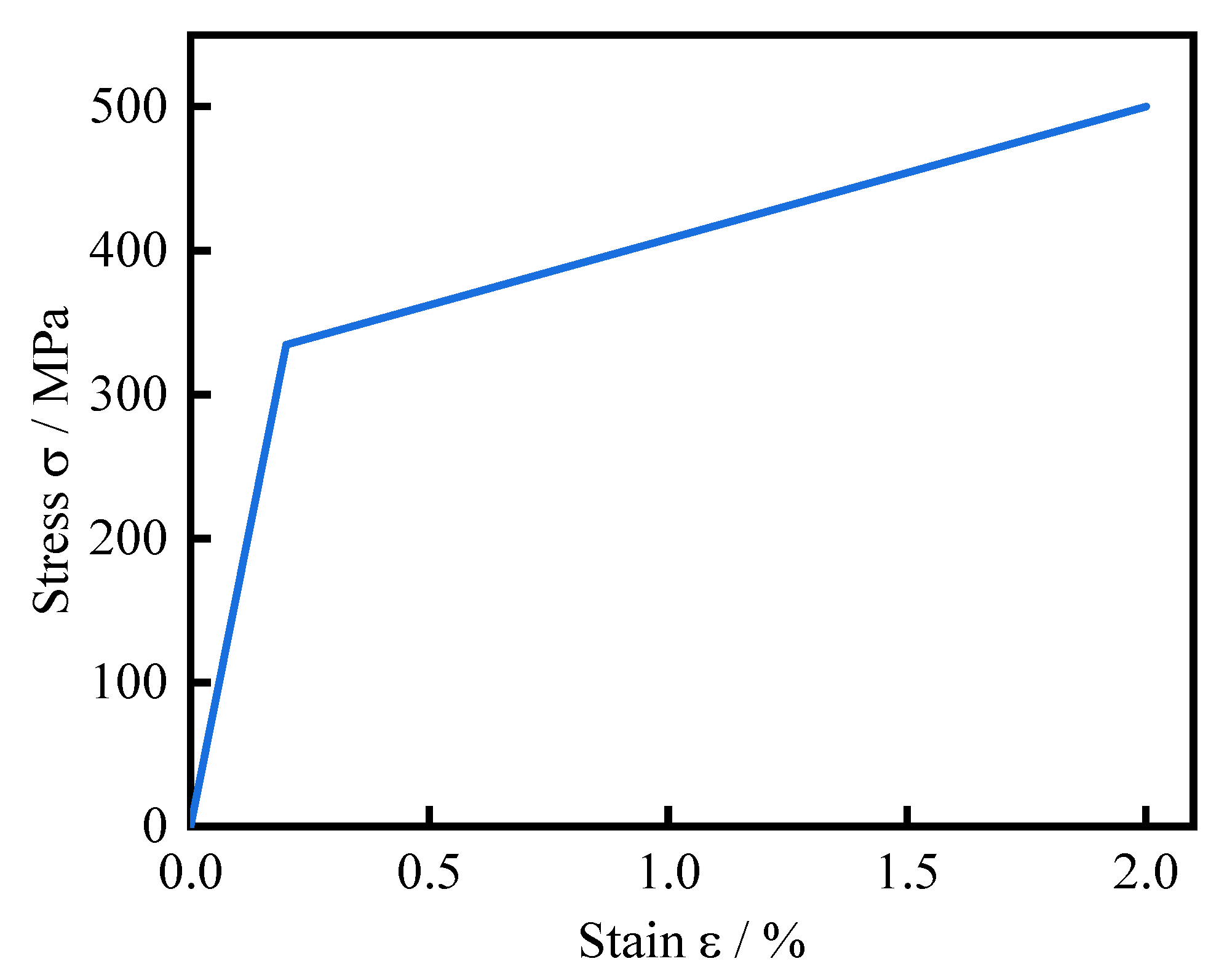
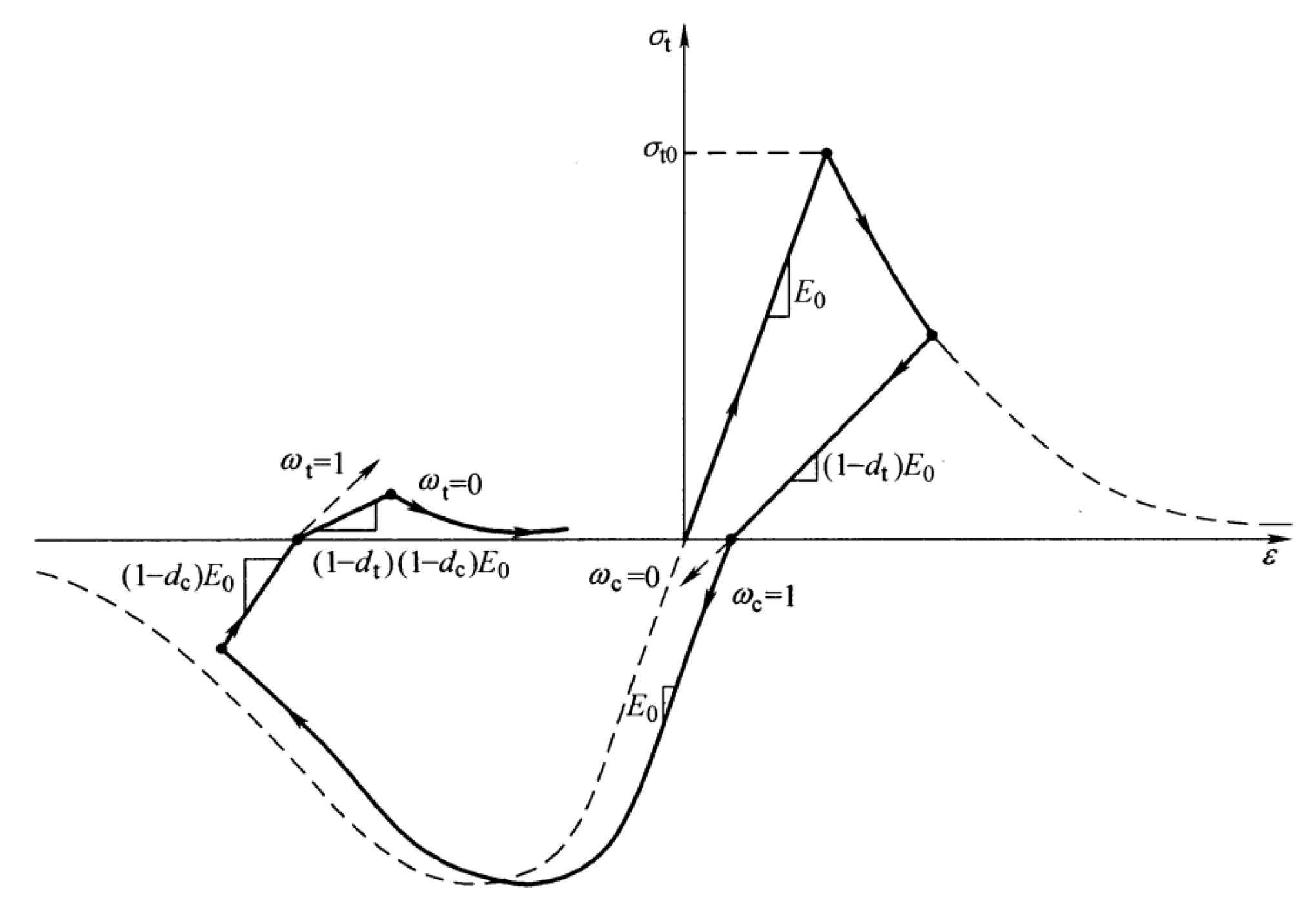
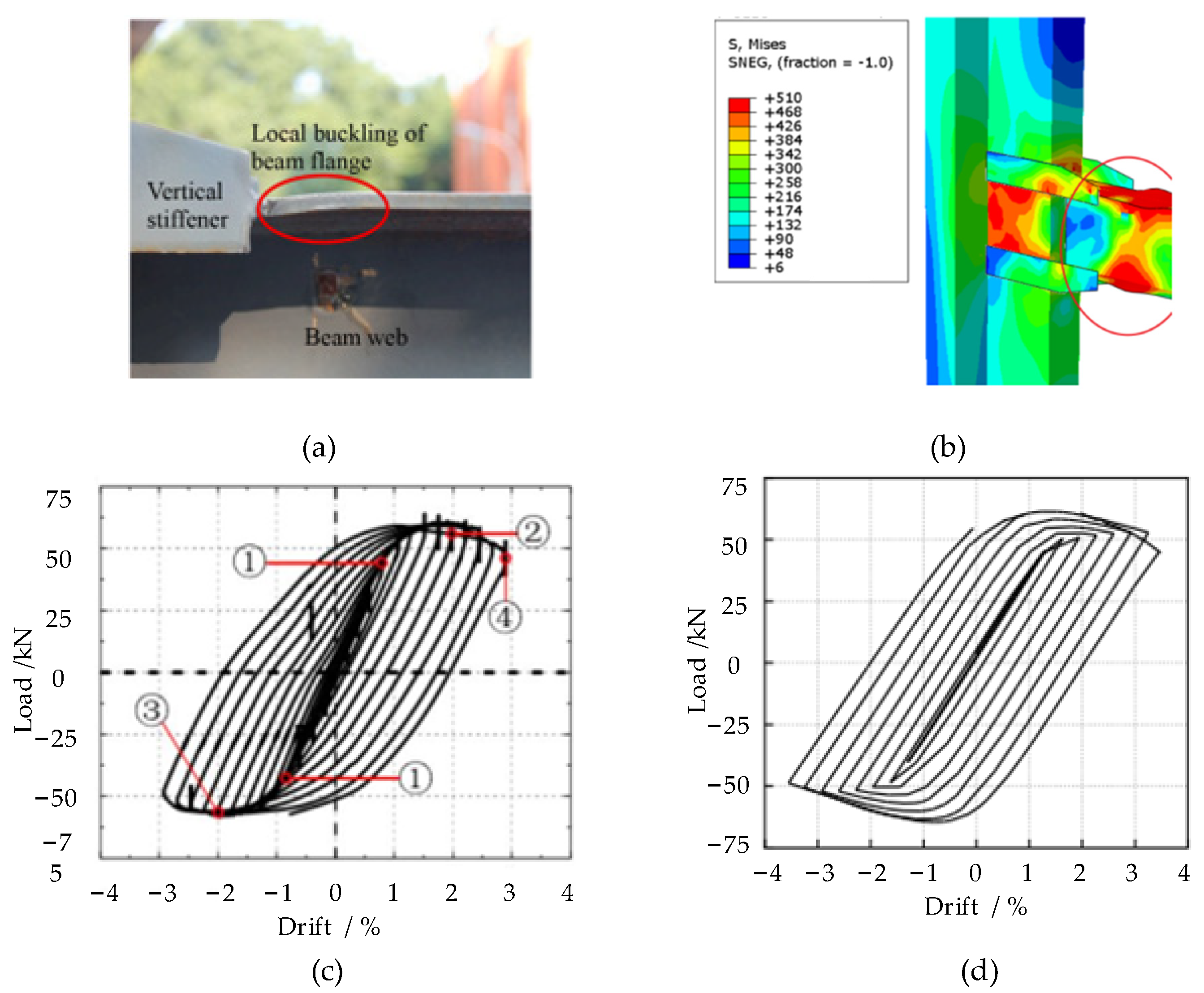
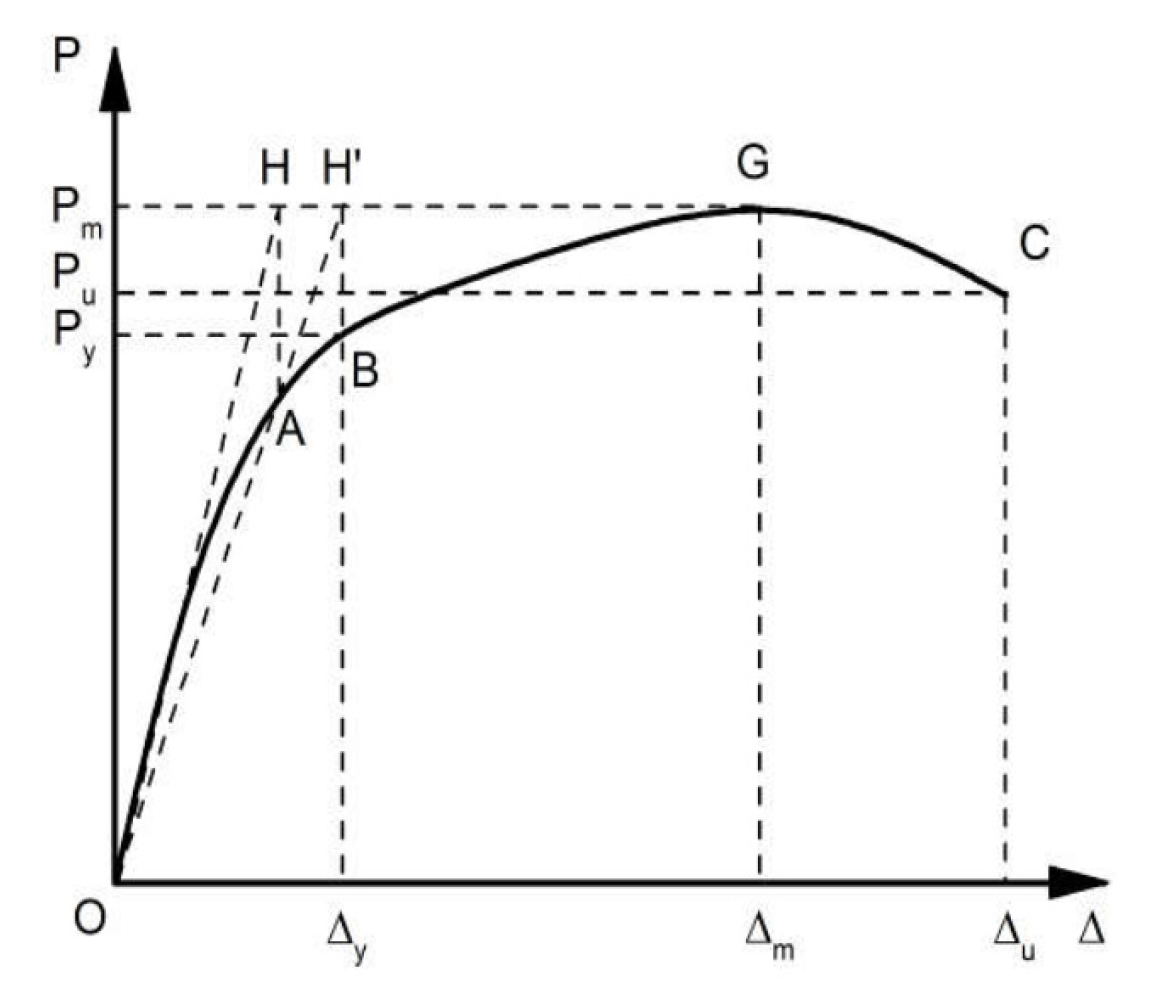
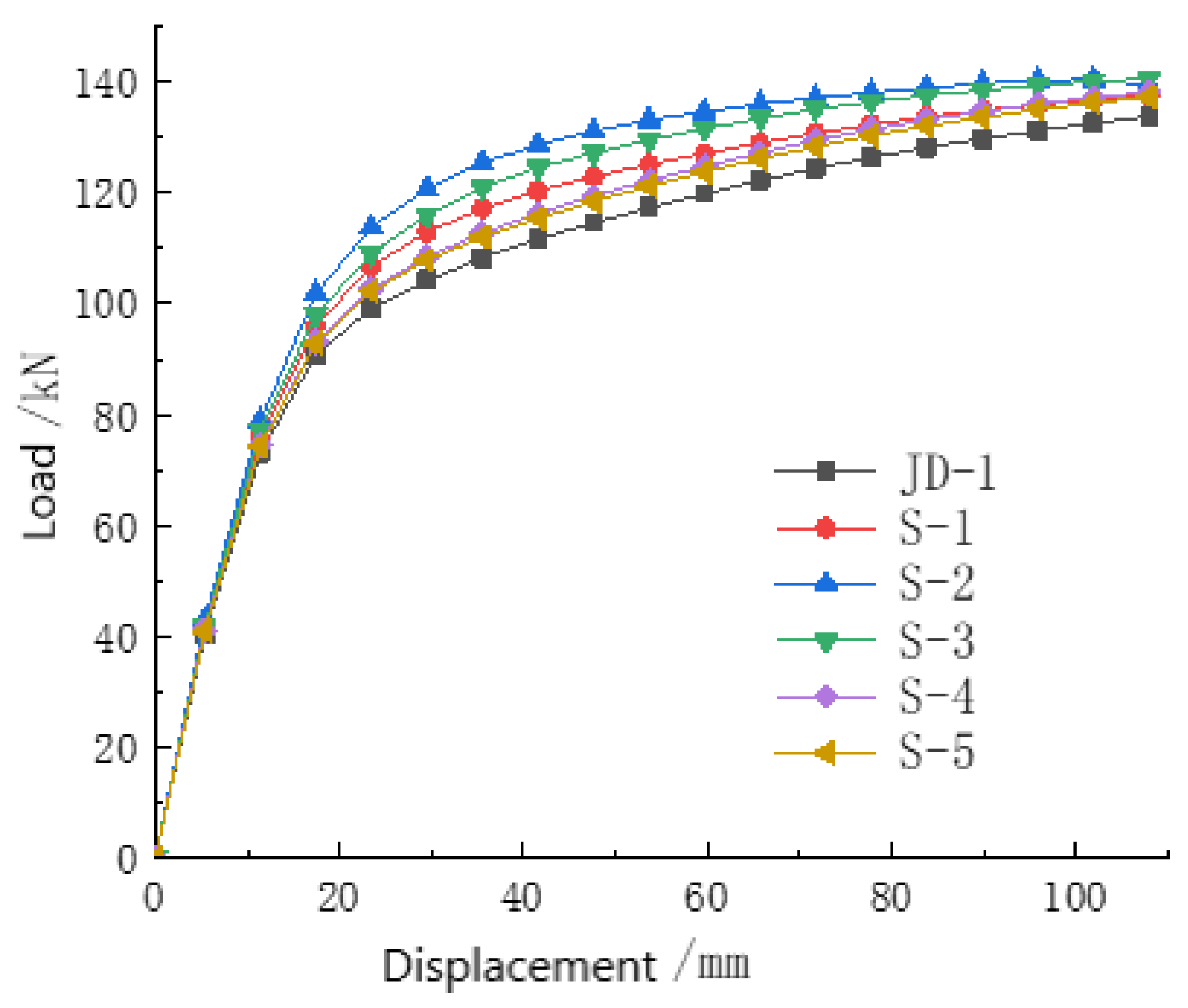
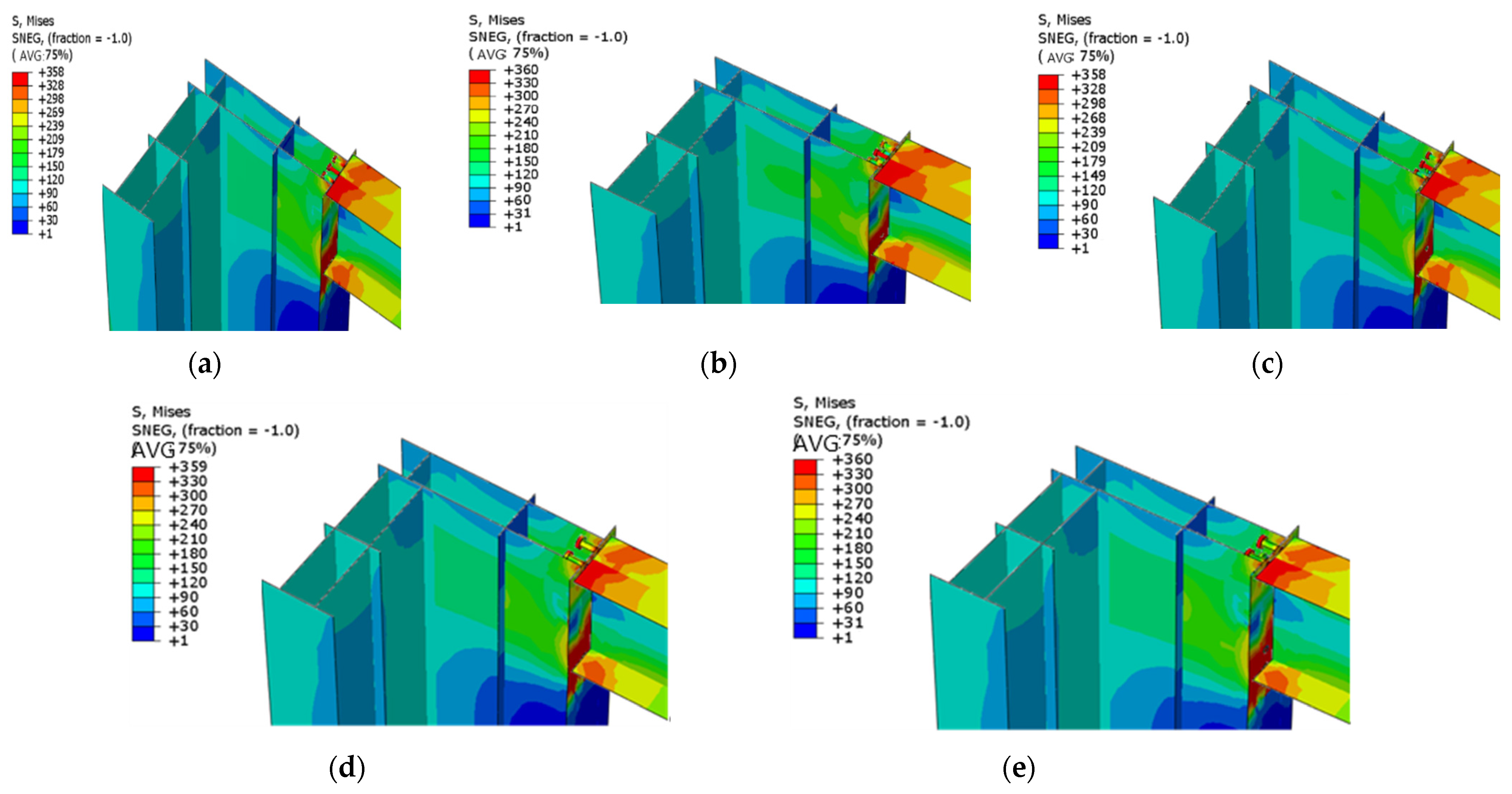
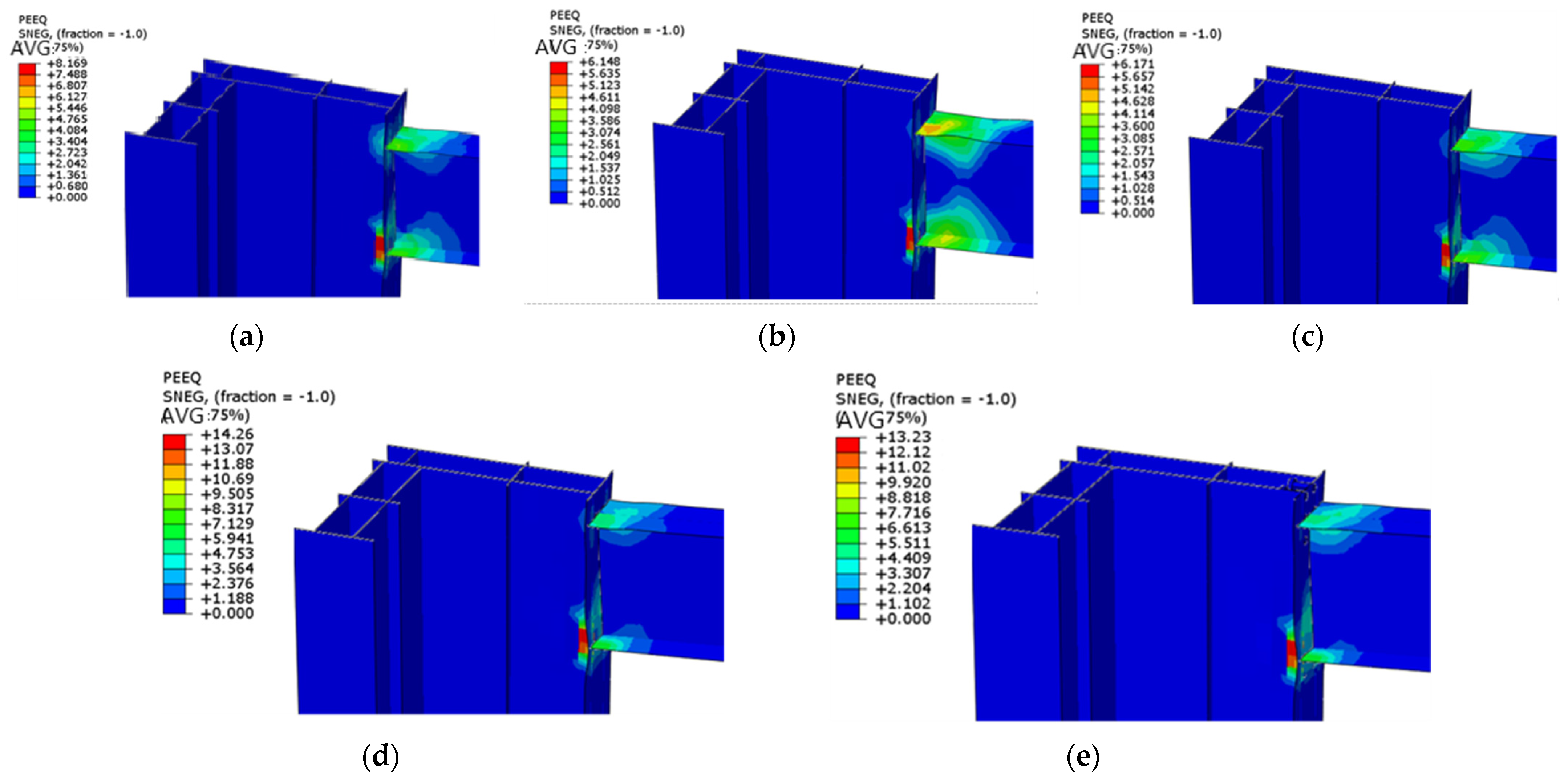
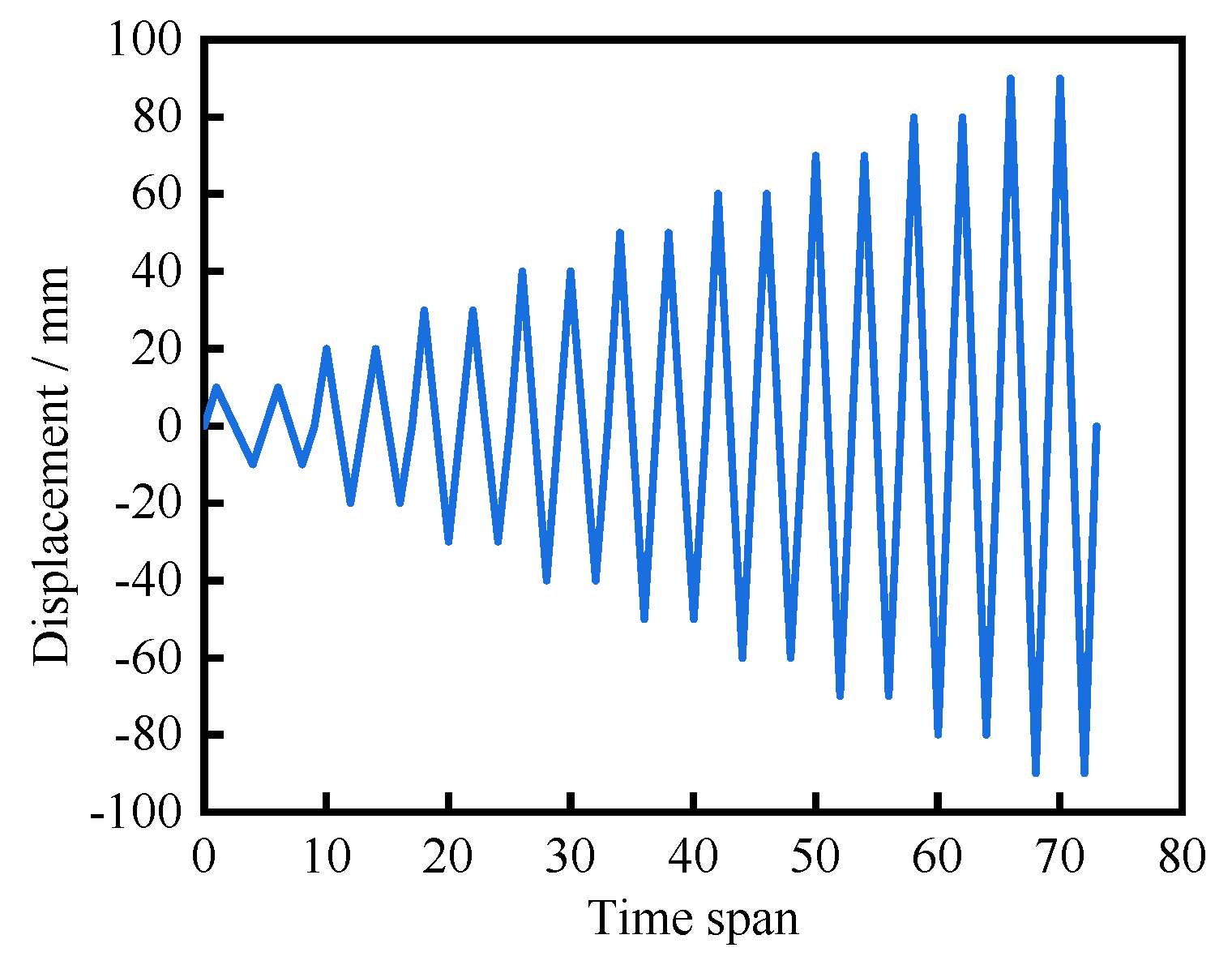

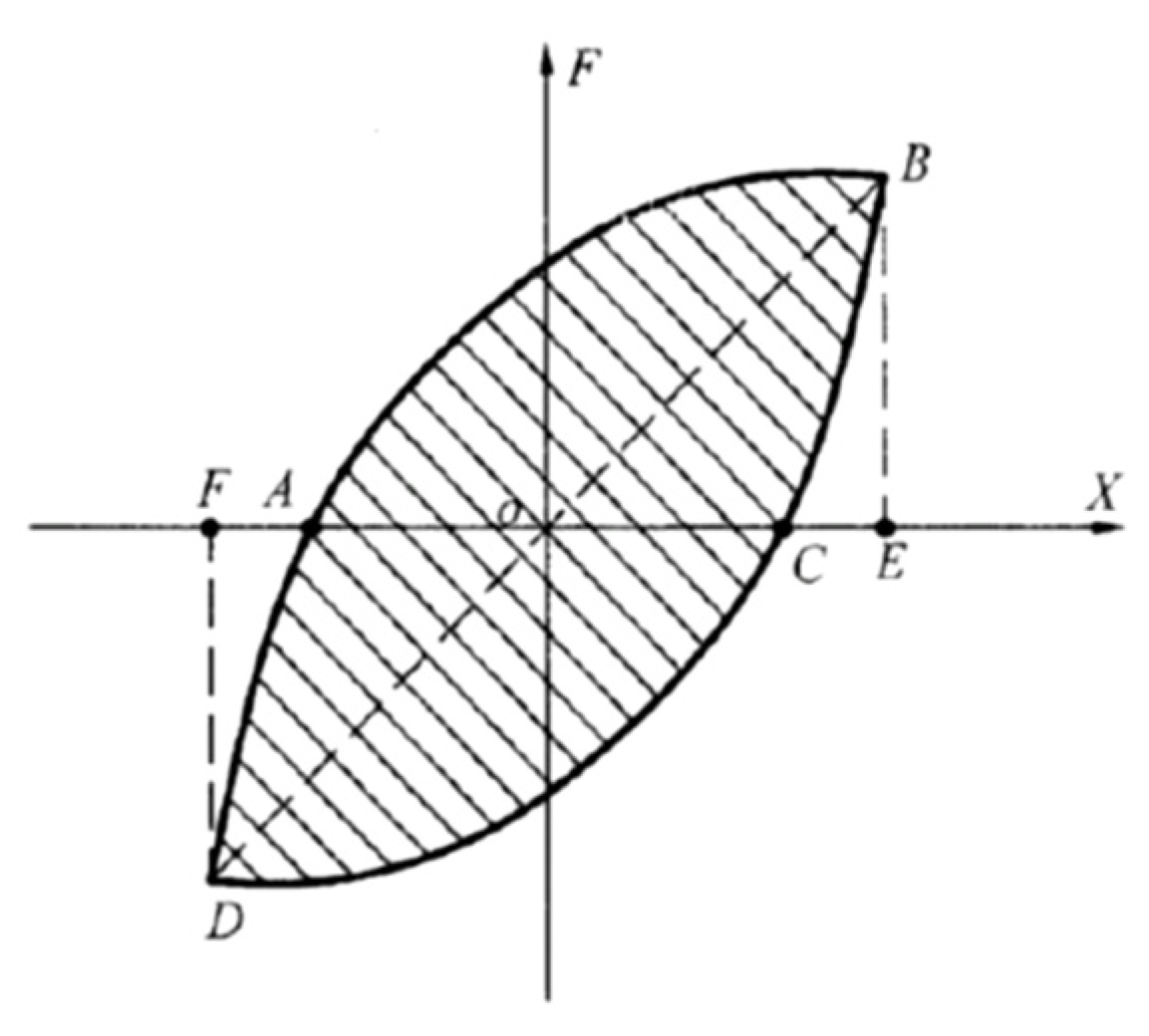

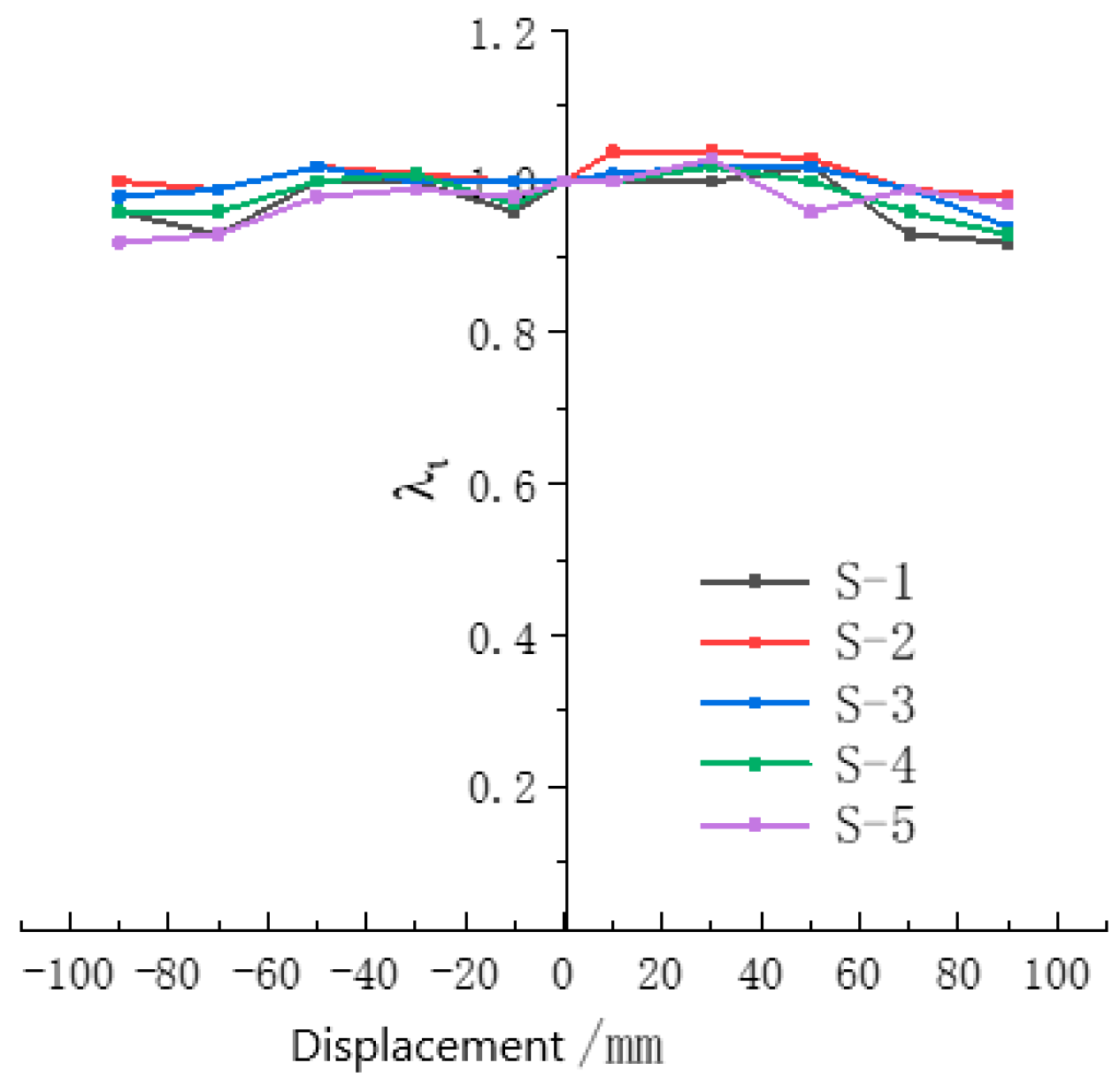
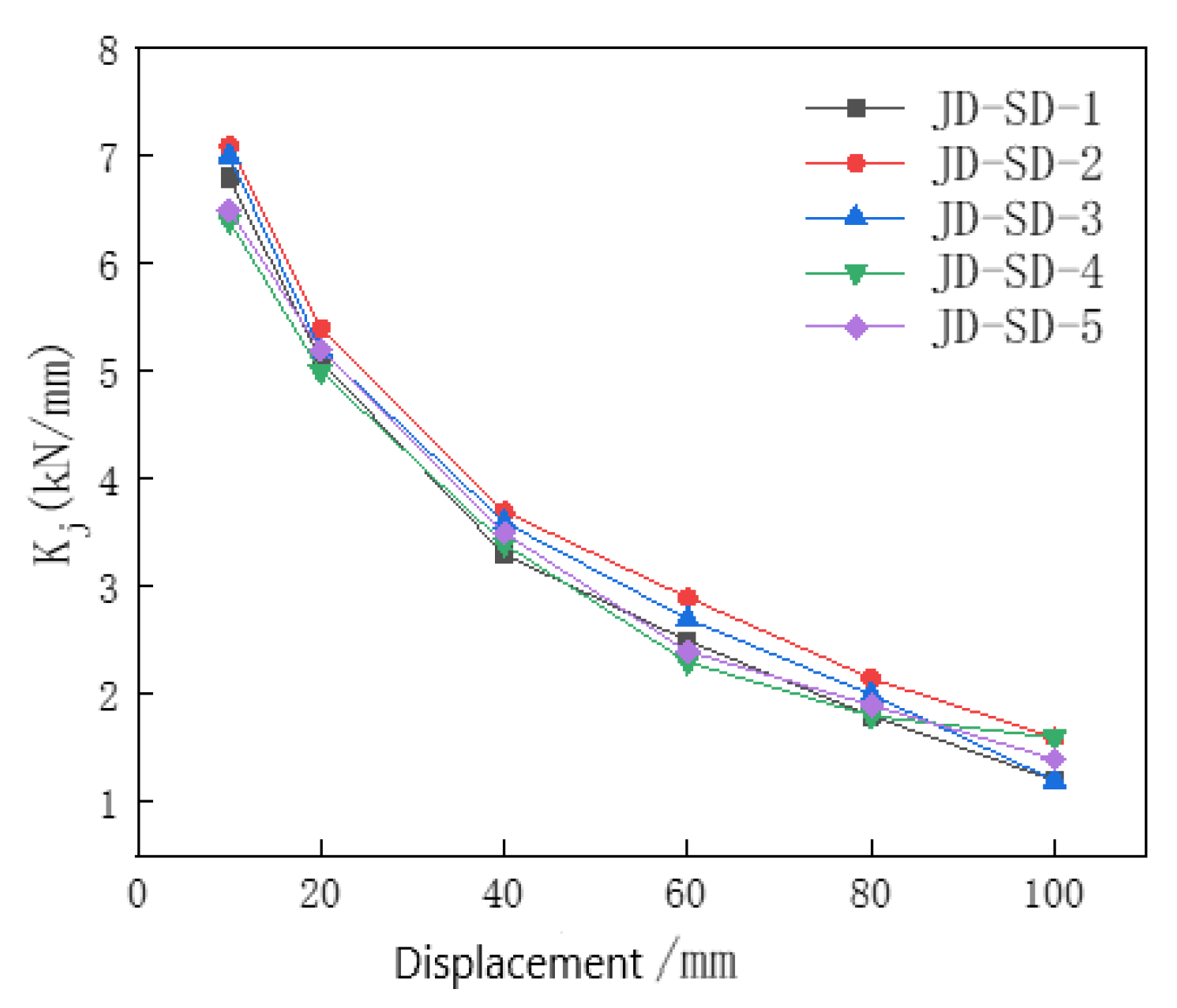
| Number | Cylindrical Head Stud Size | Studs Distribution and Spacing | |||
|---|---|---|---|---|---|
| S-1 | 10 | 18 | 7 | 40 | 1 row |
| S-2 | 10 | 18 | 7 | 40 | 3 row; spacing 2 |
| S-3 | 10 | 18 | 7 | 40 | 3 row; spacing 4 |
| S-4 | 16 | 29 | 8 | 50 | 1 row |
| S-5 | 16 | 29 | 8 | 50 | 3 row; spacing 2 |
| fb0/fc0 | Viscosity Parameter | ||||
|---|---|---|---|---|---|
| 0.2 | 30° | 0.1 | 1.16 | 0.6667 | 0.005 |
| Model | Yield Bearing Capacity/kN | Yield Displacement/mm | Ultimate Bearing Capacity/kN |
|---|---|---|---|
| JD | 99.1 | 20 | 128 |
| S-1 | 106.7 | 24.5 | 133.7 |
| S-2 | 113.8 | 23 | 139 |
| S-3 | 109 | 24 | 137.6 |
| S-4 | 102 | 26 | 133.1 |
| S-5 | 102.7 | 26 | 132 |
| Number | Energy Dissipation Coefficient E | Equivalent Viscous Damping Coefficient |
|---|---|---|
| S-1 | 2.31 | 0.35 |
| S-2 | 2.49 | 0.39 |
| S-3 | 2.46 | 0.39 |
| S-4 | 2.44 | 0.37 |
| S-5 | 2.21 | 0.36 |
Disclaimer/Publisher’s Note: The statements, opinions and data contained in all publications are solely those of the individual author(s) and contributor(s) and not of MDPI and/or the editor(s). MDPI and/or the editor(s) disclaim responsibility for any injury to people or property resulting from any ideas, methods, instructions or products referred to in the content. |
© 2023 by the authors. Licensee MDPI, Basel, Switzerland. This article is an open access article distributed under the terms and conditions of the Creative Commons Attribution (CC BY) license (https://creativecommons.org/licenses/by/4.0/).
Share and Cite
Mu, Z.; Yang, Y.; Gao, Z.; Jiang, Z. Mechanical Behavior of Special-Shaped Double-Web Steel-Reinforced Concrete Column Joints. Metals 2023, 13, 601. https://doi.org/10.3390/met13030601
Mu Z, Yang Y, Gao Z, Jiang Z. Mechanical Behavior of Special-Shaped Double-Web Steel-Reinforced Concrete Column Joints. Metals. 2023; 13(3):601. https://doi.org/10.3390/met13030601
Chicago/Turabian StyleMu, Zaigen, Yuqing Yang, Ziqi Gao, and Zhelong Jiang. 2023. "Mechanical Behavior of Special-Shaped Double-Web Steel-Reinforced Concrete Column Joints" Metals 13, no. 3: 601. https://doi.org/10.3390/met13030601





